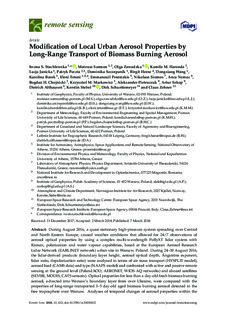Modification of local urban aerosol properties by long-range transport of biomass burning aerosol
| dc.contributor.author | Stachlewska, Iwona S. | |
| dc.contributor.author | Samson, Mateusz | |
| dc.contributor.author | Zawadzka, Olga | |
| dc.contributor.author | Harenda, Kamila M. | |
| dc.contributor.author | Janicka, Lucja | |
| dc.contributor.author | Poczta, Patryk | |
| dc.contributor.author | Szczepanik, Dominika | |
| dc.contributor.author | Heese, Birgit | |
| dc.contributor.author | Wang, Dongxiang | |
| dc.contributor.author | Borek, Karolina | |
| dc.contributor.author | Tetoni, Eleni | |
| dc.contributor.author | Proestakis, Emmanouil | |
| dc.contributor.author | Siomos, Nikolaos | |
| dc.contributor.author | Nemuc, Anca | |
| dc.contributor.author | Chojnicki, Bogdan H. | |
| dc.contributor.author | Markowicz, Krzysztof M. | |
| dc.contributor.author | Pietruczuk, Aleksander | |
| dc.contributor.author | Szkop, Artur | |
| dc.contributor.author | Althausen, Dietrich | |
| dc.contributor.author | Stebel, Kerstin | |
| dc.contributor.author | Schuettemeyer, Dirk | |
| dc.contributor.author | Zehner, Claus | |
| dc.date.accessioned | 2018-04-26T12:03:10Z | |
| dc.date.available | 2018-04-26T12:03:10Z | |
| dc.date.created | 2018-03-07T15:58:52Z | |
| dc.date.issued | 2018 | |
| dc.identifier.issn | 2072-4292 | |
| dc.identifier.uri | http://hdl.handle.net/11250/2496143 | |
| dc.description.abstract | During August 2016, a quasi-stationary high-pressure system spreading over Central and North-Eastern Europe, caused weather conditions that allowed for 24/7 observations of aerosol optical properties by using a complex multi-wavelength PollyXT lidar system with Raman, polarization and water vapour capabilities, based at the European Aerosol Research Lidar Network (EARLINET network) urban site in Warsaw, Poland. During 24–30 August 2016, the lidar-derived products (boundary layer height, aerosol optical depth, Ångström exponent, lidar ratio, depolarization ratio) were analysed in terms of air mass transport (HYSPLIT model), aerosol load (CAMS data) and type (NAAPS model) and confronted with active and passive remote sensing at the ground level (PolandAOD, AERONET, WIOS-AQ networks) and aboard satellites (SEVIRI, MODIS, CATS sensors). Optical properties for less than a day-old fresh biomass burning aerosol, advected into Warsaw’s boundary layer from over Ukraine, were compared with the properties of long-range transported 3–5 day-old aged biomass burning aerosol detected in the free troposphere over Warsaw. Analyses of temporal changes of aerosol properties within the boundary layer, revealed an increase of aerosol optical depth and Ångström exponent accompanied by an increase of surface PM10 and PM2.5. Intrusions of advected biomass burning particles into the urban boundary layer seem to affect not only the optical properties observed but also the top height of the boundary layer, by moderating its increase. | nb_NO |
| dc.language.iso | eng | nb_NO |
| dc.rights | Navngivelse 4.0 Internasjonal | * |
| dc.rights.uri | http://creativecommons.org/licenses/by/4.0/deed.no | * |
| dc.title | Modification of local urban aerosol properties by long-range transport of biomass burning aerosol | nb_NO |
| dc.type | Journal article | nb_NO |
| dc.type | Peer reviewed | nb_NO |
| dc.description.version | publishedVersion | nb_NO |
| dc.rights.holder | © 2018 by the authors. | nb_NO |
| dc.source.volume | 10 | nb_NO |
| dc.source.journal | Remote Sensing | nb_NO |
| dc.identifier.doi | 10.3390/rs10030412 | |
| dc.identifier.cristin | 1571231 | |
| dc.relation.project | EC/H2020/654109 | nb_NO |
| dc.relation.project | NILU - Norsk institutt for luftforskning: 116074 | nb_NO |
| cristin.unitcode | 7460,57,0,0 | |
| cristin.unitname | Atmosfære og klima | |
| cristin.ispublished | true | |
| cristin.fulltext | original | |
| cristin.qualitycode | 1 |
Tilhørende fil(er)
Denne innførselen finnes i følgende samling(er)
-
Publikasjoner fra Cristin - NILU [1363]
-
Vitenskapelige publikasjoner [1098]
Vitenskapelige artikler, kapitler og monografier.

